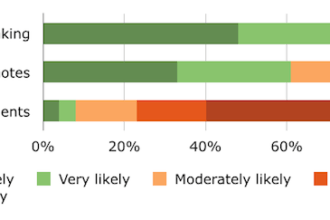Imagine a world where sick patients can get a doctor’s care from the comfort of their living room and where physicians have the flexibility to set a schedule that fits their needs and the needs of their patients. For a growing number of doctors and patients, that scenario is a reality as telemedicine continues to grow.
Telemedicine involves using technology to connect doctors to patients. From mobile diagnosis to video chat appointments, the applications are nearly limitless. This new technology system is poised to play a huge role in the future of medicine and has great potential; however, it also has some obstacles to overcome.
Potential
Many physicians seem to already be on board with the idea of telemedicine—in theory. A recent survey found that almost nine in 10 family doctors said they would use telemedicine to treat their patients if they were compensated for it. The majority of surveyed doctors also agreed that telemedicine has the potential to improve physician access and patient care. Doctors around the country seem to be in agreement that telemedicine has large potential.
One of the biggest selling points of telemedicine is the flexibility it provides to doctors and patients. Instead of having to bring a sick child into the clinic, parents can connect with doctors via a smartphone. For patients living in rural areas or those who are homebound, telemedicine makes it possible for them to still get the care they need without vast and inconvenient travel times. Instead of wasting time in waiting rooms, telemedicine efficiently uses time and allows doctors and patients to maximize their time by removing all of the waiting periods. Telemedicine also increases the number of available doctors for a patient. Instead of waiting for months to see a specialist in person, a patient could potentially connect to a specialist much more quickly via telemedicine. It also makes it easy to get a second opinion and see a variety of doctors for different perspectives.
Aside from the convenience, costs are also much lower with telemedicine than with traditional office visits. The American Hospital Association recently reported that one telemedicine program saved 11% in costs and more than tripled ROI for its investors. Money is also saved by giving doctors the ability to attract new patients, reduce the missed costs of no-show appointments, and reduce overhead of office space.
Setbacks
With the vast potential of telemedicine also comes a number of potential setbacks ranging from logistical to emotional.
For one thing, there are potentially ethical and legal repercussions of treating patients remotely. If a provider is licensed or has BLS recertification in a certain geographic region but treats a patient in another state, is he subject to the rules and regulations of the state where he is practicing? Who is responsible if the treatment fails or the diagnosis is incorrect—the doctor, the patient, or the telemedicine service provider? Because telemedicine is so new and quickly growing, many of these questions have yet to be answered.
Telemedicine also requires large amounts of time and money for the initial setup. Doctors and medical staff will need to not only invest in new equipment like webcams, cloud-based servers, and tablets but also spend the time to be trained on them. There is also a large concern of what will happen if the equipment doesn’t work properly. The convenience of telemedicine can be negated with a slow Internet connection or a faulty computer. So while telemedicine may save money eventually, the start-up costs are rather high and could lead to a loss of jobs as efficiency improves.
Many physicians and patients are also concerned about the quality of care through telemedicine. While many diagnoses and tests can be done remotely, not everything can be, including things as simple as basic checkups. In most cases, telemedicine allows patients to connect with whatever doctor is available, which is convenient but can lead to reduced care continuity if a patient is seeing someone different every time who doesn’t know their full health history.
Telemedicine will undoubtedly continue to grow rapidly over the coming years. The real test now is if we can scale growth to increase convenience while also maintaining our current care and treatment levels.









